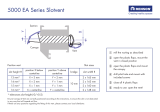
13
Preparation and Setup
Duct Length Calculation Table
The maximum straight duct length for the hood is deter-
mined by the type of duct used. See the chart below.
Duct Size Maximum Duct Run
8-inch Round 60 feet
10-inch Round 50 feet
3 1/4-in x 10-in Rectangular 50 feet
For each elbow and transition added, a certain length must
be subtracted from the maximum duct run to compensate
for wind resistance.
Use the chart below to determine the maximum length of
your duct run:
1. Write the total length of your duct run, then
2. Subtract all of the ductwork equivalent lengths in the
chart below.
Ductwork Equivalent Lengths
Piece Subtract Piece Subtract
8-inch
90° Elbow
7 feet 10-inch 90° Elbow 5 feet
8-inch
45° Elbow
3 feet 10-inch 45° Elbow 2 feet
3¼ in x 10 in
to Round 90°
Transition
25 feet
3¼ in x 10 in to 8
in / 10 in Round
Transition
4 feet
Roof Cap *
Wall Cap with
Damper
*
* The equivalent lengths of roof and wall caps vary with
model and configuration.
Ductwork Tips
Wherever possible, reduce the number of transitions, turns,
and sharp angles. Two staggered 45° angles are better
than one sharp 90° angle.
Keep turns as far away from the RNIVS exhaust as pos-
sible, and keep as much space between any bends as pos-
sible.
For best performance: use round duct instead of rectangu-
lar, especially when elbows are required.
If multiple elbows are used, try to keep at least 24 inches of
straight duct between each elbow.
Avoid using “S” or back-to-back adjacent elbows.
In extremely cold weather regions, use thermal breaks, i.e.,
short sections of non-metallic duct, to avoid indoor heat
loss. Locate the break as close as possible to the outside
pass-through point.
Do not use flexible metal duct. Do not use ductwork that is
smaller than what is advised in the tables.
To prevent backdrafts, a damper at the duct outlet may
also be required.
Planning the Ductwork
WARNING
• To prevent combustion by-products, smoke or odors
from entering the home and to improve efficiency, tape
all duct joints securely.
• Range hoods may interrupt the proper flow of smoke
and combustion gases from furnaces, gas water heat-
ers, and fireplaces. To avoid drawing lethal gases into
the home, follow the manufacturer’s recommendation
for these devices and consult NFPA and ASHRAE rec-
ommendations.
• Failure to install a remote blower or proper ductwork
may result in a backdraft and/or insufficient venting of
smoke and fumes.
• DO NOT install an additional in-line or external blower
to increase the length of the duct run. Even small dif-
ferences between blower air flow rates can greatly
reduce the air draw by the hood.
CAUTION
To reduce the risk of fire and to properly exhaust air, be
sure to duct air outside the house or building. Do not vent
exhaust air into spaces within walls or ceilings or into
attics, crawl spaces or garages.
• Local building codes may require the use of makeup air
systems with ventilation systems that move air greater
than the specified movement rate (CFM). The specified
rate varies based on locale. Consult a qualified HVAC
specialist when designing the system for the require-
ments in your area and to assure optimal performance.
• All ductwork materials (including screws and foil tape)
must be purchased separately by the customer.
• Make sure ductwork does not interfere with floor joists
or wall studs.
• On dual exhaust models, the two 8-inch exhausts may
be merged into one 10-inch duct using Dacor transition
kit ATD10. See page 12 for details.
• Fasten all joints with sheet metal screws and seal with
certified duct tape or foil tape.
• When planning new ductwork, always look for the
shortest, most direct route to the outside.
• To prevent a backdraft, never decrease the duct size
over the run. If existing ductwork is smaller than 8
inches in diameter, remove it and replace it with 8-inch
ductwork.
WARNING
During duct installation, make sure there are no
obstructions that keep the damper flaps on the top of the
hood from opening.




















